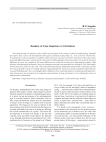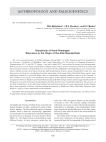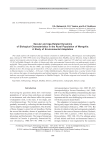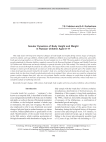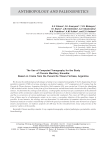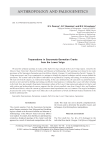Anthropology and paleogenetics. Рубрика в журнале - Archaeology, Ethnology & Anthropology of Eurasia
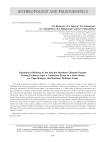
Статья научная
This study reconstructs biological affinities in a cranial sample from a collective burial on Cape Bratyev in Babushkin Bay. The burial, found in a rock niche on the Okhotsk Coast, was excavated by S.P. Efimov in 1976 and tentatively attributed to the Old Koryak culture. The sample consists of 13 adult skulls of differing preservation—five male, five female, and three undeterminable. Genome-wide analysis was carried out at the Center for Geogenetics of the University of Copenhagen. Paleogenetic data support the archaeological hypothesis attributing the burial to the Old Koryak culture. The results of the craniometric analysis suggest that the Old Koryak population was heterogeneous. Cranial data indicate population contacts between ancient Koryaks and the Epi-Jōmon people of Hokkaido. Also, they reveal common episodes in the population history of the group from Cape Bratyev and the Okhotsk culture people. Two of the three Okhotsk samples used for comparative analysis demonstrate very close affinities with individuals studied. According to the previous studies and our current analysis, the Okhotsk people resulted from the admixture of ancient groups related to Chukchi and Eskimo, on the one hand, and Tungus-Manchu groups, on the other. A significant difference between the Old Koryak population and that of Okhotsk culture is that the former includes a component related to Nivkhs.
Бесплатно
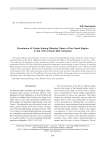
Prevalence of caries among Siberian Tatars of the Omsk region in the 17th to early 20th centuries
Статья обзорная
Бесплатно
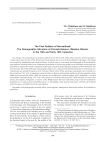
Статья научная
Sex and age were determined in a skeletal sample from an 18th to early 19th century cemetery at Krivoshchekovo, a rural center since the mid-1790s. Historical records mention the area as the Krivoshchekovo Ob region. The village was founded by immigrants from European Russia. Archival sources concerning the demography of Krivoshchekovo were analyzed, mortality tables were constructed, proportions of various age groups were calculated, and average age of death was estimated for adults. Limitations of the study stem from the fact that the population of Krivoshchekovo was not stationary. The results of the paleodemographic analysis are compared with information from two archival sources: confessional lists and parish registers of St. Nicholas Church, where births, marriages, and deaths were recorded over the period from 1763–1841. Comparative material relates to Russian old residents and the local Tatar population of the Omsk Irtysh region in the 1600s–1800s. Sex and age were estimated in a skeletal sample of 462 individuals—one third of the number of deaths during 1763–1841, when people were buried at the graveyard. Child mortality was lower than among old residents, immigrants, or natives of the Middle Irtysh. The most vulnerable group in the Krivoshchekovo population were young women and children aged 1–4. The findings of the skeletal study agree with those derived from archival sources, and likely mirror the real situation.
Бесплатно
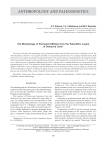
The morphology of permanent molars from the Paleolithic layers of Denisova cave
Статья обзорная
Бесплатно
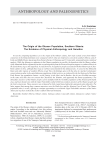
Статья
To test the competing hypotheses as to the origin of the Okunev culture, four male cranial series from Okunev cemeteries in the Minusinsk Basin were compared with 23 other pre-Andronovo series from southern Siberia, and 45 Early and Middle Bronze Age groups from Eastern Europe (24 Yamnaya and 21 Catacomb), using multivariate statistical analysis. While the Afanasyevo admixture in the Okunev population is possible, the hypothesis that the Okunev culture of the Minusinsk Basin originated from the second migration from the Eastern European steppes to southern Siberia in the Early Bronze Age is not supported. It could, however, be applied to people associated with the Okunev-type (Chaa- Khol) culture in Tuva, although these may as well have descended from the Afanasyevans. As concerns the Minusinsk Basin and other regions of southern Siberia except Tuva, the fi ndings agree with the idea of a marked evolutionary conservatism peculiar to the autochthonous populations of that territory, as evidenced by the fact that each of the three Early Bronze Age population clusters—on the Yenisei, in the Altai, and in Baraba—has its own Neolithic ancestors in the same area (this does not concern the Chaa-Khol, the Yelunino, and apparently the Samus populations). The immediate ancestors of the Okunev people can be identifi ed with the Neolithic population of the Krasnoyarsk-Kansk area, and more distant ones with the Upper Paleolithic southern Siberian common ancestors of the Okunev people and the Native Americans. These ancestors are evidenced by both cranial data (indirectly) and genetic data (directly). The la tter suggest that among these common ancestors were the Malta boy and the Afontova Gora II male. The Okunev population, then, is a relic, offeri ng us a unique opportunity to see what the Upper Paleolithic ancestors of the Native Americans may have looked like in their southern Siberian homeland.
Бесплатно
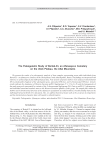
The paleogenetic study of Bertek-33, an Afanasyevo cemetery on the Ukok plateau, the Altai Mountains
Статья
We present the results of a paleogenetic analysis of bone samples representing seven adult individuals from Bertek-33—an Afanasyevo cemetery on the Ukok plateau, in the Altai Republic, Russia. The fi ndings are interpreted with reference to archaeological and anthropological data. Four systems of genetic markers were analyzed: mitochondrial DNA, polymorphic fragment of the amelogenin gene, autosomal STR-loci, and Y-chromosomal STR-loci. Genetic results indicate the dominance of Western Eurasian mtDNA haplogroups (T, J, U5a, K, H) and the homogeneity of the male gene-pool represented by variants of the Y-chromosomal haplogroup R1b. Data on mtDNA, Y-chromosome, and individual autosomal markers attest to the Western Eurasian affi nities of this group. The sample falls within the mtDNA and Y-chromosomal diversity of the Afanasyevo population of southern Siberia. Possible kinship between the individuals buried at Bertek-33 is discussed. Also, we address theoretical issues such as the accuracy of comparisons and the interpretation of genetic data with regard to cultural features.
Бесплатно
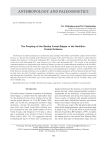
The peopling of the Baraba forest-steppe in the Neolithic: cranial evidence
Статья обзорная
Бесплатно
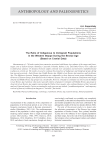
Статья
Measurements of ~730 male crania from cemeteries associated with Bronze Age cultures of the steppe and foreststeppe zone of Eastern Europe (Yamnaya, Catacomb, Poltavka, Babino, Lola, and Timber-Grave) were subjected to multivariate analyses. D2 distances between sample centroids were calculated, and non-metric multidimensional scaling was carried out. The results are used to evaluate the proportion of indigenous and immigrant groups during four successive periods—Early Bronze Age, Middle Bronze Age, Middle to Late Bronze Age transition, and Late Bronze Age. The differences between Yamnaya populations are comparable to those between recent groups inhabiting vast territories of Eastern Europe, from Karelia to the Northern Caucasus. The ro le of the substrate component in the origin of Early and Middle Bronze Age groups was considerable. However, virtually no continuity was observed at the Middle to Late Bronze Age transition, when post-Catacomb cultures originated. Continuity with Middle Bronze Age groups is observed in Late Bronze Age samples representing the Timber-Grave people, who combined features of the Catacomb and post-Catacomb people. Factors accounting for such a process may include “pendulum migrations” and temporary reversal of funerary tradition from kurgans to “invisible” fl at burials.
Бесплатно

